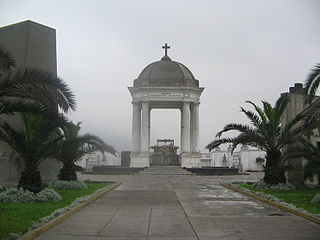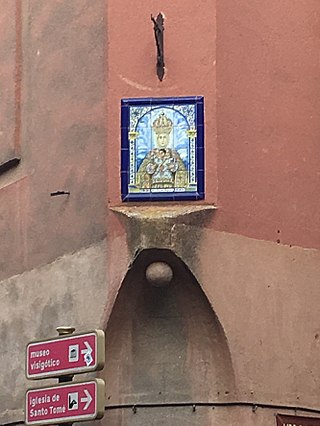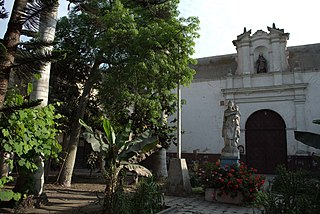This article contains content that is written like an advertisement .(August 2017) |
Subterranean Toledo is an underground city in Toledo, Spain made up of wells, caves, Roman, Arabic, and Jewish baths, as well as cemeteries.
This article contains content that is written like an advertisement .(August 2017) |
Subterranean Toledo is an underground city in Toledo, Spain made up of wells, caves, Roman, Arabic, and Jewish baths, as well as cemeteries.

There are many wells in Toledo. Aljibes are commonly found nearby wells that derive their name from a Spanish word originating from Arabic word meaning 'cistern.'
The best known cave in Toledo is the Cave of Hercules. There are several legends surrounding this cave, but the most recognized is the story of how Don Rodrigo in part caused the fall of Spain to the Moors by completing Hercules’ prophecy and opening the cave. Some private residences within the old town also have historic caves that are sometimes available to the public, and sometimes caves can be found beneath homes.

Another large part of the Toledo underground is the Roman, Arabic, and Judaic baths. Included on the list of known historic baths in Toledo are: the Baños del Ángel, the baños de Tenerías, the Baños del Caballel, and the Baños del Cenizal which are all Arabic baths one can visit. There is also the reconstructed Roman baths of the Plaza de Amador de los Ríos, [1] and finally underneath a house in the Jewish Quarter there is thought to be a mikveh, for purification baths – for which naturally running water was needed. [2]
The "cementerio general de la Vega Baja” was first built in part to accommodate for the massive increase in the death toll from cholera. The cemetery took in new graves from 1836 to 1893, at which time the families actually had to move deceased loved ones’ graves to the cemetery of Our Lady of the Sagrario, when the city announced they would be demolishing the deteriorating cemetery. There were also several smaller church and hospital-specific cemeteries around the city. [3] Outside of the old Hospital de la Misericordia there was a cemetery that began as a burial place for all who died at the hospital, but when cholera hit, it quickly became a cemetery strictly for the nuns who lived and died there. [4] Another hospital, the Hospital de Tavera, contains the crypt and marble sculpture of the Cardenal Tavera, who built the hospital. Another crypt exists in the Iglesia de San Roman, and within lies skeletons and even some well-remained mummies, and another mummy, that of King Sancho IV was found in 1947 in the Cathedral of Toledo. [5] In 2008, a previously undiscovered Jewish cemetery was found during a routine archeological excavation that always takes place before new construction begins. [6]

Toledo is a city and municipality of Spain, the capital of the province of Toledo and the de jure seat of the government and parliament of the autonomous community of Castilla–La Mancha.
These lists of cemeteries compile notable cemeteries, mausolea, and other places people are buried worldwide. Reasons for notability include their design, their history, and their interments.

La Recoleta Cemetery is a cemetery located in the Recoleta neighbourhood of Buenos Aires, Argentina. It contains the graves of notable people, including Eva Perón, presidents of Argentina, Nobel Prize winners, the founder of the Argentine Navy, and military commanders such as Julio Argentino Roca. In 2011, the BBC hailed it as one of the world's best cemeteries, and in 2013, CNN listed it among the 10 most beautiful cemeteries in the world.

Almuñécar is a Spanish city and municipality located in the southwestern part of the comarca of the Costa Granadina, in the province of Granada. It is located on the shores of the Mediterranean sea and borders the Granadin municipalities of Otívar, Jete, Ítrabo and Salobreña, and with the Malagueño municipality of Nerja. The Verde river runs through its territory. The municipality of sexitano includes the population centers of Almuñécar —municipal capital—, La Herradura, Velilla-Taramay, Torrecuevas, Río Seco, El Rescate and El Cerval.

The National Archaeological Museum is a museum in Madrid, Spain. It is located on Calle de Serrano beside the Plaza de Colón, sharing its building with the National Library of Spain.

El Cementerio de Cristóbal Colón, also called La Necrópolis de Cristóbal Colón, was founded in 1876 in the Vedado neighbourhood of Havana, Cuba to replace the Espada Cemetery in the Barrio de San Lázaro. Named for Christopher Columbus, the cemetery is noted for its many elaborately sculpted memorials. It is estimated the cemetery has more than 500 major mausoleums. Before the Espada Cemetery and the Colon Cemetery were built, interments took place in crypts at the various churches throughout Havana, for example, at the Havana Cathedral or Church Crypts in Havana Vieja.

Presbyter Matías Maestro Cemetery, formerly the General Cemetery of Lima, is a cemetery, museum and historical monument located in the Barrios Altos neighbourhood of Lima District, in Lima, Peru. Inaugurated on May 31, 1808, it was the first pantheon in the city since burials were previously held in the city's churches. It was named in honour of its designer, Spanish priest Matías Maestro.

Encarnación de Díaz is a town and municipality located in the far northeast of the state of Jalisco in north-central Mexico. It is located in a natural pass that connects the Los Altos region of Jalisco to points north, and from pre-Hispanic times until the 20th century, it was a major thoroughfare for north-south travel. The town began as a way station along a road built through this pass in the 17th century, formally becoming a town in 1760. It began to function as a municipality in the latter 19th century, but this status was not confirmed until the early 20th. Transport, along with numerous prosperous haciendas supported the economy of the area until the early 20th century, when travel patterns and the Mexican Revolution spurred its decline. In the 1920s, it was a centre of rebellion during the Cristero War, and the town contains Mexico's only museum exclusively dedicated to this episode in history. It also contains a museum dedicated to various naturally occurring mummies which have been found in the municipal cemetery.

The Espada Cemetery was located in the Barrio of San Lazaro approximately a mile west of the city walls, near the cove of Juan Guillen and close to the San Lázaro Leper Hospital. In use from 1806 to 1878, the Espada Cemetery was the first public burial place designed and constructed in Havana; prior to the cemetery, the Havana custom had been to bury the dead in the vaults of the churches such as Iglesia del Espíritu Santo in Havava Vieja. It was named after the Bishop incumbent at the time of design, José Díaz de Espada y Landa. Its boundaries included the present streets of San Lázaro, Vapor, Espada, and Aramburu. Despite being officially called Campo Santo, the people of Havana referred to the cemetery as el Cementerio de Espada. The cemetery was closed in 1878 and demolished in 1908, only a small wall remains of the original structure.

San Sebastian is a redundant church in Toledo, Spain. Originally a mosque, it was converted for use as church after the Reconquista. It is protected by the heritage listing Bien de Interés Cultural.

The Panteón Nacional Román Baldorioty de Castro is a tract of land in Barrio Segundo of the city of Ponce, Puerto Rico, originally designed as the city's cemetery, but later converted into what has come to be a famous burial place. Established in 1842, it is Puerto Rico's first national pantheon. It is the only cemetery dedicated as a museum in Puerto Rico and the Caribbean. Prior to being dedicated as a Panteón Nacional, it was known as Cementerio Viejo or as Cementerio Antiguo de Ponce, and is listed under that name on the U.S. National Register of Historic Places. The Pantheon is named after Román Baldorioty de Castro, a prolific Puerto Rican politician, and firm believer of Puerto Rican autonomy and independence. His remains are located here. The Pantheon also houses a small museum about the history of autonomism in the Island, and it is currently used both as a park and a venue for the expression of culture and the arts. It is called the Museo del Autonomismo Puertorriqueño.

View and Plan of Toledo is a landscape painting by El Greco. The image is notable for its juxtaposition of the view of Toledo with the trompe l'oeil map of the city's streets. In the composition, El Greco also included an allegory of the Tagus River, a scene of the Virgin Mary placing a chasuble on Saint Ildefonsus, and an elevation of the Tavera Hospital floating on a cloud. It was probably originally commissioned by Pedro Salazar de Mendoza and is currently preserved in the El Greco Museum in Toledo, Spain.

The Hospital de Tavera, also known as the Hospital de San Juan Bautista, Hospital de afuera, or simply as Hospital Tavera, is an important building of Renaissance architecture located is in the Spanish city of Toledo. It was built between 1541 and 1603 by order of the Cardinal Tavera. This hospital is dedicated to John the Baptist and also served as pantheon for its patron, Cardinal Tavera. Initially it began to be constructed under the supervision of Alonso de Covarrubias, being succeeded by other architects, with Bartolomé Bustamante finishing the work.
The Baños del Caballel or Baños del Cabalillo are an Islamic public baths located in Toledo, in Castile-La Mancha, Spain. The first references to the Baños del Caballel date back to 1183. The preserved architectural remains are under the buildings of the Plaza del Infantes, 13 and 14 and the numbers 5 and 6 of the Plaza de las Fuentes. The plant is not well-defined by access problems and destruction caused by building houses, but it seems to be organized in a transverse nave of access to which three are offset longitudinally, corresponding to the cold, warm and hot rooms.
The Baños del Ángel or Baños de Zeid are an Islamic baths located in the city of Toledo, in Castile-La Mancha, Spain. These are undoubtedly one of the best preserved among the eight that still maintain recognizable structures within the Historic Quarter of Toledo.

Old Town of Cáceres is a historic walled city in Cáceres, Spain.

Before the standardization of modern plumbing, 2 common ways existed to access water in Toledo, Spain. These include the Tagus river that runs alongside the city, water wells and water reservoirs. Water wells and reservoirs were generally placed inside the city centre, or in some cases, individual housing. They were generally denoted by a water well or reservoir indicator (pictured). Generally the indicators consisted of small stone balls. In cases of a fire, the public would know who had a water well or reservoir. Many streets that had these wells/reservoirs were entitled as such, with many sharing the name "Well Street".

The Cemetery of San Fernando is located in the San Jerónimo district, north of the city of Seville, Andalusia, Spain. It was built in 1852, and it is the only municipal cemetery in the city. It has an area of 28 hectares and is considered as one of the most famous cemeteries in Spain.

The La Tablada Israelite Cemetery, also known simply as the La Tablada Cemetery, is a Jewish cemetery located in the city of La Tablada, in the Greater Buenos Aires conurbation of Argentina. It was established in 1936 and is operated by the Asociación Mutual Israelita Argentina (AMIA).

The Royal Hospital of Saint Andrew, originally known as the Hospital of Our Lady of the Conception, was a hospital in the neighbourhood of Barrios Altos, part of the historic centre of Lima, Peru.